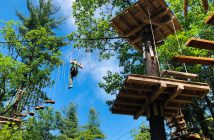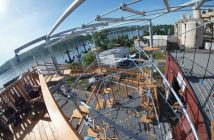Following a mid-2018 ribbon-cutting, New York state is home to an innovative aerial course for adaptive learning. The extensive installation at Root Farm in Sauquoit, roughly 100 miles west of Albany, is one of the first all-abilities obstacle courses in the world, says Mike Barker, the course creator and COO of Adventure Mas, a 35-year-old company that provides adventure-based building and training.

A favorite feature of many of the participants at Root Farm.
Barker has been designing and constructing aerial parks since the 1970s. When Root Farm asked him to lead this project, he was ecstatic. The nonprofit organization located on a 112-acre plot offers agricultural, equine, and recreational therapy programs for all ages and abilities.
“We wanted to create a high course for adaptive use, plus low obstacles and adaptive methods for zip lines and rock climbing areas,” Barkers explains. The aims were largely the same as for a typical installation, with low courses geared toward teamwork, and high courses focused on challenging an individual’s effort and education.
Beyond the adaptive high ropes course, the user-friendly adventure site includes a 30-foot-high zip line, which incorporates a Head Rush ZipSTOP braking system, along with a second high ropes course that’s primarily used for team building, plus three low ropes courses, and both a climbing wall and a separate rock-climbing site. The climbing wall is built into the zip line landing platform, which is constructed on telephone poles. The wall is equipped with Head Rush auto belays. For an on-rock experience to complement the climbing tower, Barker also manufactured handholds onto the face of the farm’s 30-foot-high limestone cliff.
Barker first surveyed the property in 2015. Following three years of development, the all-inclusive adventure course launched last summer with team building and recreational programs. To date, close to 400 participants have clipped into the system, according to former Root Farm executive director Jeremy Earl.
Building for Success
“It’s amazing to witness the transformations of people when they’re able to participate in something that they never thought they would be able to do,” says Earl. “An 80-year-old nun checked zip lining off her bucket list with us. That same day, a family visited us whose 16-year-old son was diagnosed with terminal brain cancer and losing motor function. Zip lining was something that his sister, mom, and dad had done before, and hadn’t thought it was something they could do as a family. Our adaptive equipment gave them the opportunity to zip line together,” reflects Earl.
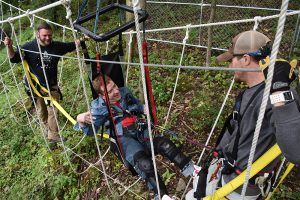
Root Farm uses adaptive equipment such as the Arc harness in order to make the course accessible to all.
“I couldn’t have asked someone to translate what we wanted better. [Barker] understood us as an organization, and he knew the population we were working with. I really cannot give enough kudos to him,” says Earl.
Over the past 30 years, designing an all-inclusive course has never been far from his mind, Barker says. As a rock climber, he is also active with the American Alpine Club, and has spoken with blind climbers—including Erik Weihenmayer, the first blind person to summit Everest—and athletes with prosthetics in order to understand their perspective on how they learn and excel in their beloved sport.
Then, in a freak accident, Barker was cutting down trees in his yard when a tree branch, two inches in diameter, shot like an arrow into his face, shattering his eye socket. After two years, multiple surgeries, and fierce determination, he regained use of his eye, which is surrounded by a titanium socket.
Being temporarily vision-impaired gave Barker additional insight into the disabled world. “You have no depth perception with just one eye. The double-vision that I had for a while played into my innate curiosity and questioning of creating obstacle courses: ‘How would I get through a course with no depth perception, and how do we make the course obtainable?’” explains Barker.
Unique Belay Systems
The major breakthrough innovation of Root Farm’s adaptive high ropes course lies in the way Barker utilized the Saferoller continuous belay system, a trolley-style device that rides on a single cable. “No one had ever used it as a support piece for course participants. The user’s weight is supported as they move themselves across,” explains Barker.
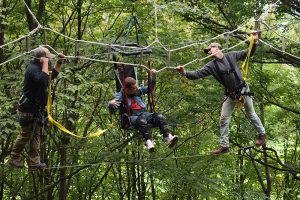
Guides assist a participant through the course.
Now, people of all abilities can challenges themselves physically and mentally while being suspended 30 feet above the ground. Root Farm equips most guests with full-body Robertson harnesses but uses an Arc harness, which is almost like a chair, for users with specific mobility needs.
Adjacent to the Saferoller system is a second Kong continuous belay system, so that able-bodied friends and guides can complete the course side-by-side with the disabled, and rescuers can access individuals quickly in case they need assistance.
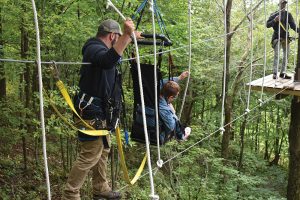
The dual line allows for guides to assist those with limited mobility through the course.
That led to another accommodation: the dual-line aerial course was engineered to carry the weight of at least two people. That means the cable needs to be much stiffer and heavier than typical cables—and Barker’s team needed to install it all by hand. It wasn’t an easy job. For quality control, the team included only Barker and four other highly capable builders.
Once the adaptive course was constructed, it received two weeks of fine-tuning, mostly due to the unique use of the Saferoller continuous belay system. If a three-inch change was made with the cable at a particular element, then the entire course required adjustment at every connector point.
Since some of the adaptive activities start or end well above ground level, Barker employed 4-1 belay and hoisting systems in several spots. “Utilizing the 4-1, for every four pounds you lift you put in one pound of force, so it helps keep strain off the person lifting the rope,” Barker says.
To lower guests from the zip line arrival platform, a metal arm is attached to a pole via a pivot, and a 4-1 system lowers guests from the platform. A series of double pulleys are anchored to substantial supports on roofs or trees, explains Barker.
“We also use the 4-1 system at Root Farm to transport someone from a wheel chair to the adaptive high ropes course, so that they can bring themselves through it. It’s basically a lifting system,” he explains. “There’s also a locking system, so as the person goes up, it locks. They are also on belay, so if anything goes wrong with 4-1 system, they are still safe.”
High Ropes Challenge
The elements of the high ropes course include a Burma bridge, cargo net, ladder, wire walk, and vertical ropes.
“The ropes and the Burma bridge are really easy obstacles, so if someone has a little fear, they can get through those first elements pretty easily. Then the next element in either direction is a bit more complicated and difficult. We want someone to self-select an early out if it’s not for them,” explains Earl. “We all measure success differently. For some people, it’s walking out to the course or getting the harness on. For others, it’s doing the first element or completing the course as fast as they can,” he says.
Regardless of someone’s starting point, or physical or mental abilities, now everyone has a chance to test their own ability to grow and face challenges.
And for Barker, witnessing that inaugural adventurer complete the course for the first time made all of the sweat investment more than worthwhile.
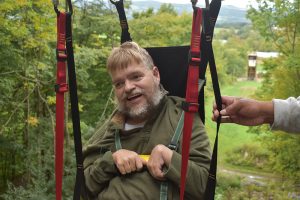
All smiles.
“The first person who did the course came off smiling ear-to-ear and started crying. The guy was probably in his 20s and said, ‘I’ve never even been able to go on a swing.’ Hearing that statement meant more to me than anything. I didn’t see a dry eye around the place after that,” reflects Barker, who is inspired to build more adaptive courses, as soon as possible.
“I still almost cry every time I think of that moment. It’s a marvelous feeling to be able to open up the world for someone.”





